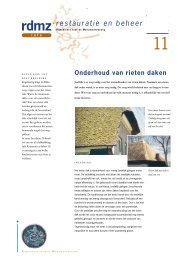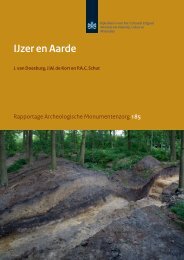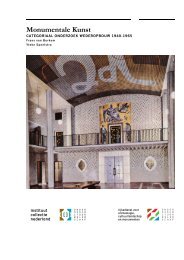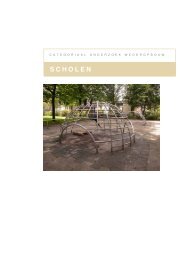Hoofdstuk 3 - Rijksdienst voor het Cultureel Erfgoed
Hoofdstuk 3 - Rijksdienst voor het Cultureel Erfgoed
Hoofdstuk 3 - Rijksdienst voor het Cultureel Erfgoed
You also want an ePaper? Increase the reach of your titles
YUMPU automatically turns print PDFs into web optimized ePapers that Google loves.
54<br />
—<br />
Summary: Earthen walls from an archaeological<br />
perspective<br />
During the historical period especially in the<br />
Pleistocene inland parts of the Netherlands<br />
many fields used to be enclosed by earthen<br />
banks. Usually these banks were wooded (wood<br />
banks). The presence of wood banks significantly<br />
contributed to the small-scale character of the<br />
landscape. Up to now the origin and distribution<br />
of wood banks and of the landscapes that they<br />
were part of have received little attention. In this<br />
paper archaeological evidence regarding leveled<br />
wood banks is presented and discussed. The<br />
most common archaeological features related to<br />
wood banks are parallel ditches up to 5 m. apart.<br />
It turns out that most wood banks are relatively<br />
young: late medieval or younger. In the southern<br />
Netherlands they appear around the 14th-15th<br />
centuries. In the north and east the oldest field-<br />
enclosing wood banks are probably 16th century.<br />
Here arable land: extensive open fields (‘essen’)<br />
as well as small reclamations (‘eenmansessen’)<br />
is usually enclosed by only one wood bank<br />
whereas in the southern Netherlands systems of<br />
wood banks occur that subdivide arable land in<br />
separate plots. The enclosure of open fields in<br />
the southern Netherlands may be early evidence<br />
of declining open field agriculture, and the emergence<br />
of ‘individual’ landscapes (Renes 2010),<br />
the emergence of which seems to be related to<br />
the so-called ‘late medieval transition’: the fundamental<br />
shift to a proto-capitalistic market<br />
economy.<br />
Convincing archaeological evidence to support<br />
claims that present-day small-scale landscapes<br />
divided by wood banks and hedges are rooted in<br />
late prehistoric times is lacking.

















